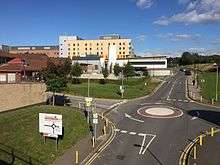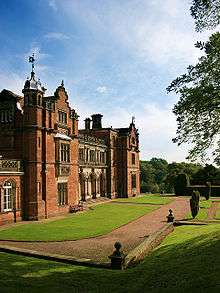Keele University School of Medicine
|
School of Medicine building named 'The David Weatherall Building' in 2012 in honour of the retiring Keele University Chancellor | |
| Type | Medical school |
|---|---|
| Established | 1978 |
Administrative staff | 80 |
| Students | c.750 |
| Location |
Keele, Staffordshire, England 53°0′22.9″N 2°15′59.3″W / 53.006361°N 2.266472°WCoordinates: 53°0′22.9″N 2°15′59.3″W / 53.006361°N 2.266472°W |
| Affiliations | Keele University |
| Website | Keele Medical School |
 | |
Keele Medical School is a medical school based on campus at Keele University near Newcastle under Lyme, Staffordshire, England. The first two years of the school's MBChB course are taught mainly on Keele University campus although early exposure to patients is of importance and in the second year there is considerable interaction in a clinical setting.
Years three to five, however, are principally taught within the Royal Stoke University Hospital in Stoke-on-Trent and the County Hospital (both part of University Hospitals North Midlands Trust), at the Royal Shrewsbury Hospital, Shrewsbury and Telford Hospital NHS Trust, North Staffordshire Combined Healthcare NHS Trust and South Staffordshire and Shropshire Healthcare NHS Foundation Trust. Medical students also have placements in general practices in Staffordshire and Shropshire.
The school originally accepted about 120 UK/EU and 10 non-EU medical students each year for the 5-year MBChB course and 10 UK/EU/non-EU students for the 6-year course. From 2011 the total accepted increased to about 150 from all sources. This number may vary depending on NHS requirements and funding.[1]
History
Establishment

The Royal Commission on Medical Education (1965–68) issued its report (popularly known as the Todd Report) in 1968 on the state of medical education in the United Kingdom. The commission estimated that by 1994 there would be a need to train more than 4,500 doctors a year for the United Kingdom, and that this would have to be achieved by both increasing the numbers of medical students at existing medical schools, and establishing a number of new ones. It recommended that new medical schools should be immediately established at the universities of Nottingham, Southampton and Leicester.
The Royal Commission considered the possibility of medical schools being established at Keele University, Hull University, Warwick University and Swansea University (then University College, Swansea). North Staffordshire was deemed a very good site as it had a growing local population and several large hospitals. However, 150 students a year would be required to make it economically and educationally viable and thus the scheme was postponed. In 1978, the Keele Department of Postgraduate Medicine opened. This department conducted medical research, and played a part in postgraduate medical education, but did not teach undergraduate medical students. In 2003, 35 years after the publication of the Todd Report, the current medical school was founded.[2]
Initial teaching
From 2002 the school began teaching clinical undergraduate medicine to clinical medical students who had completed their pre-clinical medical education at either School of Medicine, University of Manchester or the Bute Medical School (University of St Andrews). These students followed the curriculum of the Manchester School of Medicine clinical course, and after three years of clinical study at Keele, were awarded the degrees of MBChB by the University of Manchester. The first cohort of students completing their course at Keele did so in 2005. In 2003, Keele started teaching the full five-year course, using the Manchester curriculum. Both pre-clinical and clinical medical education were established in Staffordshire and Shropshire. Keele began to develop its own undergraduate medical curriculum in 2007.
Current teaching

From the 2011/12 academic year all students have followed the Keele curriculum. In January 2012 it was announced that the General Medical Council (GMC) had approved and registered the new five-year undergraduate curriculum. Students graduating in 2012 were awarded the Keele MBChB, wearing a new Keele two-colour hood reflecting the fact that students gain two degrees Bachelor of Medicine and Bachelor of Surgery. Previously medical students at Keele have graduated with a Manchester degree. The GMC visited and scrutinised progress throughout the course’s development.[3]
Keele's curriculum is integrated, with clinical experience and skills being taught in years one and two, and weekly science teaching in year three. A small number of graduate entry places are available for year two of the course and there is a six-year option for applicants with non-science qualifications. From 2006, applicants have been required to sit the UKCAT admission test. Years 1 and 2 teaching takes place on Keele University campus. Clinical teaching, years 3–5, takes place at the Royal Stoke University Hospital site, in Hartshill. Teaching at Keele also involves attachments at District General hospitals in Stafford, Shrewsbury and Telford, as well as attachments to General Practitioners (GP) in Staffordshire and Shropshire.[4]
On-line learning
Keele Medical School promotes the use of online learning material, such as Keele Basic Bites, which is a free online video-based learning tool for Keele University Medical students, created by senior academic staff, providing medical education in an entertaining, as well as an informative fashion.
Programmes
Undergraduate
- MBChB Medicine[5]
- BSc Medical Humanities
- BSc Natural Sciences with the following named routes:
(i) Neuroscience (ii) Psychology (iii) Biochemistry (iv) Studies in Biomedical Sciences
Postgraduate
- MSc European Scientific Research Training with international placement
- MMedSci (Anatomical Sciences)
- MA Medical Education
- MSc Molecular Parasitology and Vector Biology
 Keele University Medical School Extension
Keele University Medical School Extension - MSc Biomedical Engineering
- MSc Cell and Tissue Engineering
- MSc Blood Science
- MA Medical Ethics and Law
- MA Medical Ethics and Palliative Care
- MPhil Primary Care Sciences
Other research MPhils are available in clinical and laboratory sciences and this varies from year to year.[6]
Keele Medical Society
Keele medical students formed the Keele Medical Society (KMS) in 2005. The organisation aims to represent students and promote social inclusion.
Current developments
In August 2013 a £2.8m state-of-the-art Anatomy Skills Facility was completed. The school joins a select group of institutions offering leading edge facilities to attract surgeons from across the UK. It will also provide improved facilities for students and also offer senior surgeons the chance to improve high level skills.[7]
A £2.2m extension to the medical school to accommodate the Research Institute for Primary Care Health Sciences (iPCHS) is scheduled for completion in November 2016 [8] Finally, a £21m medical research facility (including new laboratories) originally scheduled for completion in Stoke-on-Trent will be constructed on the Keele campus instead.[9]
Rankings
| Complete[10] (2017, national) |
9 |
|---|---|
| The Guardian[11] (2017, national) |
4 |
| Times/Sunday Times[12] (2017, national) |
4 |
Keele has rapidly established a solid reputation for medicine. The school was ranked 4 out of the UK's 33 medical schools in The Sunday Times Good University Guide 2017 with a student satisfaction score of 92.4%.[13]
Keele was also highly ranked by students, rated in the top 3 medical establishments in the 2014, 2015 and 2016 National Student Surveys.[14] The small intake has largely contributed to instill an esprit de corps amongst the student population.
Admissions wise, for 2017 non-graduate entry, the A'level requirement is A*AA at a single sitting including Biology or Chemistry, a second science chosen from either Mathematics, Physics, Biology and Chemistry and a third subject.[15]
Last but not least, in 2015, for the traditional 5-year MBChB course, 2202 applications were made by UK/EU students with 285 offers for 119 places.[16]
See also
- Medical education in the United Kingdom
- List of medical schools in the United Kingdom
- Medical school in the United Kingdom
References
- ↑ "Would-be doctors told to be engineers instead: Bright students 'should consider a degree in something other than medicine because of huge demand for places'". Daily Mail. 18 May 2014. Retrieved 6 June 2014.
- ↑ http://medicine2.keele.ac.uk/resources/course_brochure.pdf
- ↑ A new Keele degree Keele press release 17 January 2012 accessed 19 January 2012
- ↑ http://medicine2.keele.ac.uk/resources/course_brochure.pdf
- ↑ http://medicine2.keele.ac.uk/resources/course_brochure.pdf
- ↑ http://medicine2.keele.ac.uk/resources/course_brochure.pdf
- ↑ "New £2.8m State if the Art Development for School of Medicine" – Keele University press release 1 Feb 2013, accessed 10 Feb 2013
- ↑ https://www.keele.ac.uk/estates/projects/currentprojects/primarycareextension.php
- ↑ https://www.architectsjournal.co.uk/news/keele-university-shelves-contest-after-site-rethink/10012970.article
- ↑ "University League Table 2017". The Complete University Guide. Retrieved 25 April 2016.
- ↑ "University league tables 2017". The Guardian. 23 May 2013. Retrieved 23 May 2016.
- ↑ "The Times and Sunday Times University Good University Guide 2017". Times Newspapers. Retrieved 23 September 2016.
- ↑ http://nuk-tnl-editorial-prod-staticassets.s3.amazonaws.com/2016/bespoke/university-guide/index.html
- ↑ http://medicine2.keele.ac.uk/resources/course_brochure.pdf
- ↑ http://www.keele.ac.uk/medicine/mbchb5years/entryrouteshowtoapply/
- ↑ http://themsag.com/uk-medical-schools/competition-ratios
